External links
- Falkner text scan at Internet Archive
 Falkner public domain audiobook at LibriVox
Falkner public domain audiobook at LibriVox
Falkner (1837) is the penultimate book published by the author Mary Shelley. Like Shelley's earlier novel Lodore (1835), it charts a young woman's education under a tyrannical father figure. [1]
As a six-year-old orphan, Elizabeth Raby prevents Rupert Falkner from committing suicide; Falkner then adopts her and brings her up to be a model of virtue. However, she falls in love with Gerald Neville, whose mother Falkner had unintentionally driven to her death years before. When Falkner is finally acquitted of murdering Neville's mother, Elizabeth's female values subdue the destructive impulses of the two men she loves, who are reconciled and unite with Elizabeth in domestic harmony.
Falkner is the only one of Shelley's novels in which the heroine's agenda triumphs. [2] In critic Kate Ferguson Ellis's view, the novel's resolution proposes that when female values triumph over violent and destructive masculinity, men will be freed to express the "compassion, sympathy, and generosity" of their better natures. [3]
Critics have until recently cited Lodore and Falkner as evidence of a conservative retrenchment by Shelley. In 1984, Mary Poovey identified the retreat of Shelley's reformist politics into the "separate sphere" of the domestic. [4] As with Lodore, contemporary critics reviewed the novel as a romance, overlooking its political subtext and noting its moral issues as purely familial. Betty Bennett argues, however, that Falkner is as much concerned with power and political responsibility as Shelley's previous novels. [5] Poovey suggested that Shelley wrote Falkner to resolve her conflicted response to her father's combination of libertarian radicalism and stern insistence on social decorum. [6]
Critics view Falkner neither as notably feminist, [7] nor as one of Mary Shelley's strongest novels, though she herself believed it could be her best. The novel has been criticised for its two-dimensional characterisation. [8] In Bennett's view, "Lodore and Falkner represent fusions of the psychological social novel with the educational novel, resulting not in romances but instead in narratives of destabilization: the heroic protagonists are educated women who strive to create a world of justice and universal love". [9]
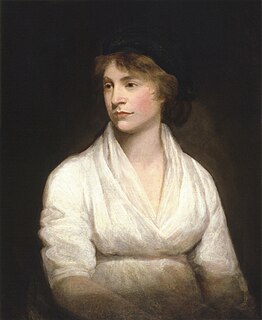
Mary Wollstonecraft was an English writer, philosopher, and advocate of women's rights. Until the late 20th century, Wollstonecraft's life, which encompassed several unconventional personal relationships at the time, received more attention than her writing. Today Wollstonecraft is regarded as one of the founding feminist philosophers, and feminists often cite both her life and her works as important influences.

The Last Man is an apocalyptic, dystopian science fiction novel by Mary Shelley, first published in 1826. The narrative concerns Europe in the late 21st century, ravaged by a mysterious pandemic illness that rapidly sweeps across the entire globe, ultimately resulting in the near-extinction of humanity. It also includes discussion of the British state as a republic, for which Shelley sat in meetings of the House of Commons to gain insight to the governmental system of the Romantic era. The novel includes many fictive allusions to her husband Percy Bysshe Shelley, who drowned in a shipwreck four years before the book's publication, as well as their close friend Lord Byron, who had died two years previously.
Mary Louise Poovey is an American cultural historian and literary critic whose work focuses on the Victorian Era. She is currently Samuel Rudin University Professor in the Humanities at New York University, and Director of the Institute for the History of the Production of Knowledge. Poovey has taught at Johns Hopkins University, Swarthmore College, and Yale University.
Mathilda, or Matilda, is the second long work of fiction of Mary Shelley, written between August 1819 and February 1820 and first published posthumously in 1959. It deals with common Romantic themes of incest and suicide. The narrative deals with a father's incestuous love for his daughter.
Betty T. Bennett (1935–2006) was Distinguished Professor of Literature and Dean of the College of Arts and Sciences (1985–1997) at American University. She was previously Dean of the School of Liberal Arts and Sciences and acting provost of Pratt Institute from 1979 to 1985. Among her numerous awards and honors, Bennett was a fellow of the National Endowment for the Humanities and fellow of American Council of Learned Societies. She won the Keats-Shelley Association of America - Distinguished Scholar Award in 1992 and was Founding President, Phi Beta Kappa, Zeta Chapter at American University. Born in Brooklyn, New York, Bennett graduated from Brooklyn College magna cum laude and later received a master's degree (1962) and PhD (1970) in English and American literature from New York University.
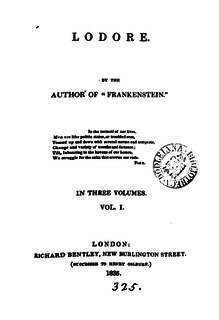
Lodore, also published under the title The Beautiful Widow, is the penultimate novel by Romantic novelist Mary Shelley, completed in 1833 and published in 1835.

Proserpine is a verse drama written for children by the English Romantic writers Mary Shelley and her husband Percy Bysshe Shelley. Mary wrote the blank verse drama and Percy contributed two lyric poems. Composed in 1820 while the Shelleys were living in Italy, it is often considered a partner to the Shelleys' play Midas. Proserpine was first published in the London periodical The Winter's Wreath in 1832. Whether the drama was ever intended to be staged is a point of debate among scholars.

Valperga: or, the Life and Adventures of Castruccio, Prince of Lucca is an 1823 historical novel by the Romantic novelist Mary Shelley, set amongst the wars of the Guelphs and Ghibellines.
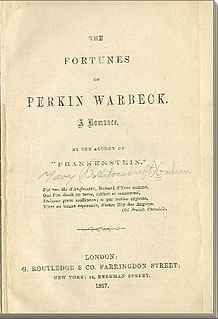
The Fortunes of Perkin Warbeck: A Romance is an 1830 historical novel by Mary Shelley about the life of Perkin Warbeck. The book takes a Yorkist point of view and proceeds from the conceit that Perkin Warbeck died in childhood and the supposed impostor was indeed Richard of Shrewsbury. Henry VII of England is repeatedly described as a "fiend" who hates Elizabeth of York, his wife and Richard's sister, and the future Henry VIII, mentioned only twice in the novel, is a vile youth who abuses dogs. Her preface establishes that records of the Tower of London, as well as the histories of Edward Hall, Raphael Holinshed, and Francis Bacon, the letters of Sir John Ramsay to Henry VII that are printed in the Appendix to John Pinkerton's History of Scotland establish this as fact. Each chapter opens with a quotation. The entire book is prefaced with a quotation in French by Georges Chastellain and Jean Molinet.
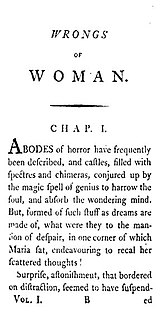
Maria: or, The Wrongs of Woman is the 18th-century British feminist Mary Wollstonecraft's unfinished novelistic sequel to her revolutionary political treatise A Vindication of the Rights of Woman (1792). The Wrongs of Woman was published posthumously in 1798 by her husband, William Godwin, and is often considered her most radical feminist work.

Letters Written During a Short Residence in Sweden, Norway, and Denmark (1796) is a personal travel narrative by the eighteenth-century British feminist writer Mary Wollstonecraft. The twenty-five letters cover a wide range of topics, from sociological reflections on Scandinavia and its peoples to philosophical questions regarding identity. Published by Wollstonecraft's career-long publisher, Joseph Johnson, it was the last work issued during her lifetime.
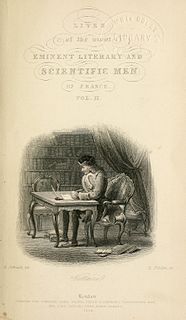
The Lives of the Most Eminent Literary and Scientific Men comprised ten volumes of Dionysius Lardner's 133-volume Cabinet Cyclopaedia (1829–1846). Aimed at the self-educating middle class, this encyclopedia was written during the 19th-century literary revolution in Britain that encouraged more people to read.

"Maurice, or the Fisher's Cot" is a children's story by the Romantic writer Mary Shelley. Written in 1820 for Laurette Tighe, a daughter of her friends Margaret King and George William Tighe, Mary Shelley tried to have it published by her father, William Godwin, but he refused. The text was lost until 1997, when a manuscript copy was discovered in Italy.

Frankenstein; or, The Modern Prometheus is an 1818 novel written by English author Mary Shelley. Frankenstein tells the story of Victor Frankenstein, a young scientist who creates a sapient creature in an unorthodox scientific experiment. Shelley started writing the story when she was 18, and the first edition was published anonymously in London on 1 January 1818, when she was 20. Her name first appeared in the second edition, which was published in Paris in 1821.

History of a Six Weeks' Tour through a part of France, Switzerland, Germany, and Holland; with Letters Descriptive of a Sail Round the Lake of Geneva and of the Glaciers of Chamouni is a travel narrative by the English Romantic authors Mary Shelley and Percy Bysshe Shelley. Published anonymously in 1817, it describes two trips taken by Mary, Percy, and Mary's stepsister, Claire Clairmont: one across Europe in 1814, and one to Lake Geneva in 1816. Divided into three sections, the text consists of a journal, four letters, and Percy Shelley's poem "Mont Blanc". Apart from the poem, preface, and two letters, the text was primarily written and organised by Mary Shelley. In 1840 she revised the journal and the letters, republishing them in a collection of Percy Shelley's writings.

Rambles in Germany and Italy, in 1840, 1842, and 1843 is a travel narrative by the British Romantic author Mary Shelley. Issued in 1844, it is her last published work. Published in two volumes, the text describes two European trips that Mary Shelley took with her son, Percy Florence Shelley, and several of his university friends. Mary Shelley had lived in Italy with her husband, Percy Bysshe Shelley, between 1818 and 1823. For her, Italy was associated with both joy and grief: she had written much while there but she had also lost her husband and two of her children. Thus, although she was anxious to return, the trip was tinged with sorrow. Shelley describes her journey as a pilgrimage, which will help cure her depression.

Mary Wollstonecraft Shelley was an English novelist who wrote the Gothic novel Frankenstein; or, The Modern Prometheus (1818), which is considered an early example of science fiction. She also edited and promoted the works of her husband, the Romantic poet and philosopher Percy Bysshe Shelley. Her father was the political philosopher William Godwin and her mother was the philosopher and feminist activist Mary Wollstonecraft.

Pamela Clemit, FRHistS is a British scholar, critic, and writer. She specializes in British literature and culture of the eighteenth and nineteenth centuries. Her work intersects with the fields of history, philosophy, and politics, and she has particular expertise in the Godwin-Shelley family of writers.

Since the initial publication of Mary Wollstonecraft Shelley's novel Frankenstein in 1818, there has existed uncertainty about the extent to which Mary Shelley's husband, Percy Bysshe Shelley, contributed to the text. While the novel was conceived and mainly written by Mary, Percy is known to have provided input in editing and publishing the manuscript. Some critics have alleged that Percy had a greater role—even the majority role—in the creation of the novel, though mainstream scholars have generally dismissed these claims as exaggerated or unsubstantiated. Based on a transcription of the original manuscript, it is currently believed that Percy contributed between 4,000 and 5,000 words to the 72,000 word novel.